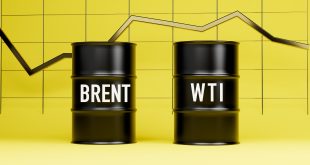Global crude oil benchmarks have plunged to their lowest levels in five months, with Brent crude trading at approximately $62.34 per barrel, down 1.67%, and WTI crude at $58.69, down 1.44%. The downturn reflects a volatile market shaken by escalating trade tensions, cautious supply management, and growing fears of a global oil glut.
Trade War Tensions Rattle Markets
Oil prices have been particularly sensitive to the ongoing trade conflict between the United States and China. After a brief rally on Monday driven by hopes of a diplomatic breakthrough, prices reversed sharply on Tuesday. The decline was triggered by China’s sanctions against five U.S. subsidiaries of South Korean shipbuilder Hanwha Ocean, citing their cooperation with U.S. investigations into Chinese maritime sectors. This move followed China’s recent export controls on rare earths, further straining relations and dampening investor sentiment.
Despite plans for a late-October summit between Presidents Trump and Xi, the renewed hostilities have cast doubt on any near-term resolution. Analysts warn that unless tensions ease, oil prices could continue to slide, with Brent potentially breaching the $60 threshold.
OPEC+ Opts for Caution
On October 5, the OPEC+ alliance approved a modest production increase of 137,000 barrels per day for November. Saudi Arabia had advocated for a more aggressive hike to reclaim market share, but ultimately compromised with Russia on a smaller adjustment. According to OPEC’s latest report, this increase is expected to narrow the supply deficit in 2026.
However, the International Energy Agency (IEA) projects a significant surplus ahead. It forecasts a 4 million barrels per day oversupply by 2026, driven by rising output from OPEC+ and other producers. The agency has revised its 2025 supply growth estimate to +3.0 million bpd, while trimming demand growth to just 0.71 million bpd. The U.S. Energy Information Administration (EIA) echoes this outlook, predicting Brent will average $62 in Q4 2025 and fall to $52 in 2026.
Demand Weakens as Economic Outlook Dims
Global fuel demand is faltering amid economic uncertainty. The IEA’s downgraded forecasts reflect slower growth, and Goldman Sachs warns that U.S. tariffs and weak data could shave 0.8 million bpd off demand expectations. Meanwhile, U.S. crude production remains near record highs at 13.6 million bpd, helping to sustain elevated inventory levels.
Geopolitical Calm Offers Brief Relief
Geopolitical risks have eased slightly following ceasefire talks between Israel and Hamas, which included the release of hostages. This development temporarily reduced oil’s geopolitical premium, though analysts caution that only a major escalation—such as involving Russia—could reverse the current bearish trend.
Energy, in general, and ude oil markets, in particular, are navigating a complex landscape of trade disputes, cautious supply strategies, and weakening demand. With oversupply risks looming and diplomatic tensions unresolved, the outlook for oil prices remains subdued.

 Noor Trends News, Technical Analysis, Educational Tools and Recommendations
Noor Trends News, Technical Analysis, Educational Tools and Recommendations




